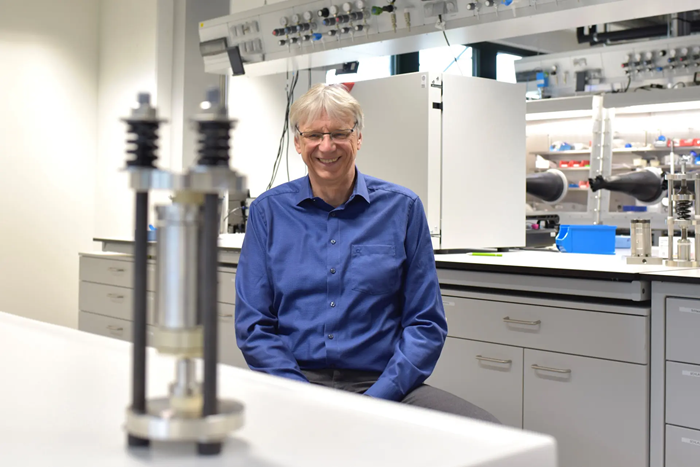Reviewed by Lexie CornerMay 12 2025
Researchers at the Technical University of Munich, led by Professor Thomas F. Fässler, have developed a new material composed of scandium, antimony, and lithium.
It enhances solid-state battery conductivity, enabling lithium-ion transport over 30 % faster than previously known materials.
 Professor Thomas F. Fässler in his laboratory at the Chair of Inorganic Chemistry with Focus on Novel Materials. Image Credit: Technical University of Munich
Professor Thomas F. Fässler in his laboratory at the Chair of Inorganic Chemistry with Focus on Novel Materials. Image Credit: Technical University of Munich
Solid-state batteries are seen as a key future technology because they store more energy and do not require flammable materials, unlike current lithium-ion batteries.
Prof. Thomas F. Fässler's team improved conductivity by partially substituting lithium with scandium in a lithium antimonide compound.
This substitution creates vacancies - specific gaps in the crystal lattice - that enable lithium ions to move more easily and rapidly, resulting in a new world record for ion conductivity.
To verify the findings, the team collaborated with Professor Hubert Gasteiger at TUM’s Chair of Technical Electrochemistry, as the measured conductivity was significantly higher than that of existing materials.
Co-author Tobias Kutsch, who conducted the validation tests, commented: “Because the material also conducts electricity, it presented a special challenge, and we had to adapt our measurement methods accordingly.”
Our result currently represents a significant advance in basic research. By incorporating small amounts of scandium, we have uncovered a new principle that could prove to be a blueprint for other elemental combinations. While many tests are still needed before the material can be used in battery cells, we are optimistic. Materials that conduct both ions and electrons are particularly well suited as additives in electrodes. Because of the promising practical applications, we have already filed a patent for our development.
Thomas F. Fässler, Professor, Technical University of Munich
The material offers faster conductivity, demonstrates thermal stability, and can be produced using established chemical methods.
According to first author and TUMint scientist Jingwen Jiang, the team has also identified an entirely new class of compounds.
Our combination consists of lithium-antimony, but the same concept can easily be applied to lithium-phosphorus systems. While the previous record holder relied on lithium-sulphur and required five additional elements for optimization, we only need only Scandium as an additional component. We believe that our discovery could have broader implications for enhancing conductivity in a wide range of other materials.
Jingwen Jiang, Study First Author, Technical University of Munich
Journal Reference:
Jiang, J., et al. (2025) Scandium Induced Structural Disorder and Vacancy Engineering in Li3Sb – Superior Ionic Conductivity in Li3−3xScxSb. Advanced Energy Materials. doi.org/10.1002/aenm.202500683.